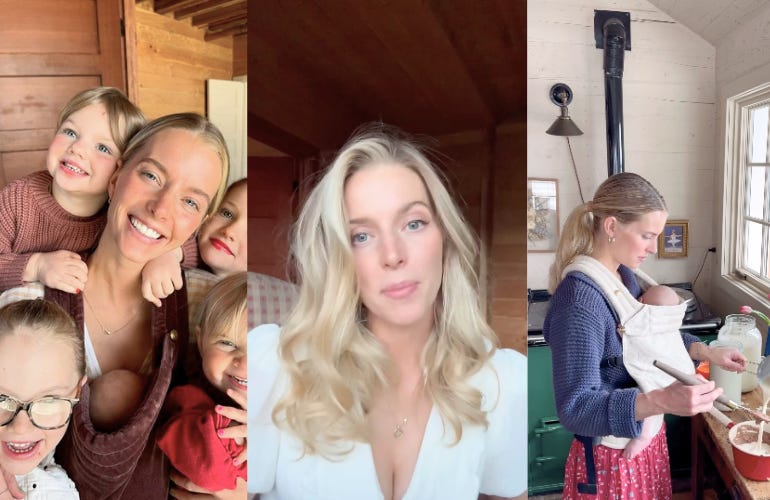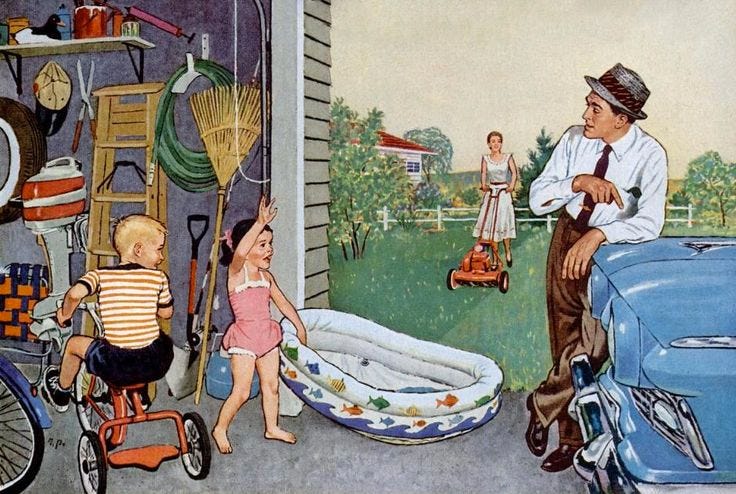The tradwife life isn't good for women—or men
Tradwives are romanticizing gender roles that aren't actually traditional.
I’ve been trying to understand why the #tradwife movement is so interesting to me, and I think I’ve figured it out. It’s because learning about the history of gender while writing this newsletter over the past year or so has made me realize that what we call “traditional” gender roles aren’t actually all that traditional.
So-called “traditional masculinity” is only a few hundred years old, and the more I learn about it the more I think it’s not good for men. It holds us back from the purpose, connection, and freedom we truly want. And that makes me think that tradwives aren’t actually good for men either. Hear me out...
If you don’t know what tradwives are, let’s catch you up.
I like writer
’s definition:“’Tradwife,’ as you may have surmised, is short for ‘traditional wife,’ and the growing tradwife movement calls for a return to an era that sort of existed for some people for a little while about 70 years ago. But unlike 1950s homemakers, modern-day tradwife influencers meticulously document every aspect of their daily lives for all the world to see—except, you know, for all the flurries of scrubbing and arranging and haranguing and arguing that I can only imagine has to go on between their carefully staged videos.”
The movement she’s talking about is an online thing. Tradwife influencers post videos bashing feminism, teaching their daughters to depend on men, explaining why they don’t leave the house after dark, milking cows, ironing their husband’s shirts, baking all kinds of stuff (using flour you can order from their online store), and how to make money on Instagram. And some make lots of money doing so. One influencer makes an estimated $200,000 a month.
They’re easy to laugh at. What’s harder is figuring out why millions of women follow them and comment things like, “I am convinced that you really are superwoman at this point. THIS is the kind of woman/mother/wife all of our daughters should be idolizing!” I recommend reading Taylor’s post. She explains what the popularity of tradwives says about the limitations of what I like to think of as “liberal feminism,” also known as “white feminism” or “#girlboss feminism” (which I wrote about earlier this year). She writes:
“Tradwifery is a backlash movement, and like so many backlash movements, it’s extreme and kind of scary. But temporarily setting aside the misogyny, religious dogma, and general ickiness, I don’t think we can ignore that there is an allure to a life in which we have the time to properly attend to ourselves, our families, and our communities.”
The reason so many women are following these influencers is because nearly everyone these days who isn’t rich is constantly strapped for time and feeling burned out.
Because of skyrocketing economic inequality, it now takes many families two incomes to pay the rising cost of living. At the same time, governments have increasingly divested from supporting the raising of children, caring for old folks, and other forms of social welfare.
Feminists like Nancy Fraser have called this the “crisis of care,” and only people at the very top of the economy can avoid it. (One of the most popular tradwife influencers is married to an heir to a commercial airline fortune and is worth an estimated $400 million.)
Tradwives, as Taylor wrote, are portraying “an era that sort of existed for some people for a little while about 70 years ago.” Those some people were wives of “only the most privileged male workers,” in the words of the late feminist writer Barbara Ehrenreich, “those who [were] members of powerful unions, or of skilled crafts and professions ... actually earned enough to support a family.”
For the past few hundred years, since capitalism began in Western Europe and then spread worldwide, many working-class women have needed to work outside the home in addition to doing unpaid household labor. Especially working-class women of color. As the cost of living has gone up over the last few decades—while worker pay has been stagnant—more and more families have been forced into this bind.
“Between the need for increased working hours and the cutback in public services, [capitalism] is systematically depleting our capacities for sustaining social bonds,” Fraser explained in a 2016 interview with Dissent. “It is stretching our ‘caring’ energies to the breaking point.”
It makes sense that many women are romanticizing tradwifery.
When you’re working 40+ hour weeks and spending the little time you have left “adulting,” why wouldn’t you envy someone else who can focus solely on raising kids, making meals, and folding laundry—and doing it all with an aura of ease and joy? The problem is most people aren’t heirs to fortunes. Most families can’t afford the rising cost of living on one income. Most of us have to work full-time to get health insurance. Most of us are caught in the hamster wheel that is hyper-individualized, deregulated, American capitalism—where our labor is exploited to fund the yachts and vacation homes of heirs to fortunes.
Taylor explains why tradwifery isn’t actually great for women. You really should read her post. She concludes:
“I have to believe we can find a happy medium that honors our right to autonomy without asking us to devalue the care work that all of us need to partake in to be connected and emotionally fulfilled human beings.”
I want to add a little here about why they aren’t good for men either. Yes, men in heterosexual relationships still don’t do our fair share of household labor (though that is slowly changing). Yes, too much of the burden of unpaid care work still falls on women’s shoulders. But our society’s underappreciation and exploitation of care work hurts men too.
Capitalism devalues care work, takes it for granted. It always has, treating raising kids, nurturing community, and maintaining the home as unpaid “women’s work,” lesser than the “real work” of earning a paycheck. This wasn’t so before a few hundred years ago. Work wasn’t always fairly distributed in pre-capitalist societies, but care work was given as much time and attention as hunting and working in the fields. They were valued equally.
As
writes in her take on tradwifery:“Until very recently it was normal for all members of a household to contribute, according to capacity, to a common enterprise that might include craft, agriculture, animal husbandry, and other productive activities as well as the care of the dependent young and very old.”
It wasn’t until the Industrial Revolution that ideas about women being “naturally” more nurturing, emotional, and relational became seen as the unquestioned truth. And the same for ideas about men being “naturally” less so. These ideas were created to justify forcing many women to stay at home to support the many men who had to work long hours in factories and fields, while also raising the next generation of workers. While these myths about gender gave men relative economic and social privilege over the women in their lives, they also hurt men too—and they continue to hold us back today.
So-called “traditional masculinity” keeps men in a cage.
We get messages as boys that expressing emotion is “soft,” “weak,” “girly.” We’re told to that our value is being competent, not caring. These outdated ideas about “real men” serve capitalism, but they cut us off from our full humanity. They make us more prone to anger issues and compulsive behaviors, like unhealthy substance use. They make us reliant on romantic partners for emotional support and less likely to have strong support networks of family and friends. They make us less likely to ask for help and seek therapy.
Men might get to dip out on childcare and household chores more than women—and we need to stop doing that. But we shouldn’t be aspiring to the 1950s. Our fathers and grandfathers might’ve had a little more clarity about their role as men in society, but they were in the cage too. Their cage was likely even harder to break out of.
The traditions we should be romanticizing and trying to bring back are the ones capitalism has destroyed. Our ancestors didn’t do it perfectly—patriarchy still existed to different degrees in different societies in different areas of the world. But many of them shared work across their extended family and community. They shared what was known as “the commons,” land and resources that weren’t private property but under collective ownership and management. There wasn’t a division between “women’s work” and “real work.” (Get this: As many as half of prehistoric humans who were big game hunters could have been biologically female.)
Harrington argues that all we need is a little deregulation to allow parents to create “small, largely home-based businesses.” I disagree. We need way more than that. We need policy change allowing everyone to work less hours (for the same pay)—regardless of gender. We need way more public funding for childcare and elderly care. We need paid parental leave—and lots of it. We need policies that incentivize more public spaces and communal living arrangements over isolated, energy-intensive, suburban housing.
It makes sense that the tradwife life is appealing to some women. And it makes even more sense that some men would want a wife to handle all of the childcare and domestic labor. But that life isn’t actually “traditional,” and it disrespects and devalues the caring, relational, and emotional dimensions of being human, which hurts all of us.
Now, a question for the comments below: How do you feel about tradwives?
(P.S. If you become a paid subscriber for $5/month, you’ll get my weekly Friday Q&A posts with practical, actionable tips for improving your relationship, plus the warm feeling of supporting my writing.)








Nicely written and points well made!
One thought - these models of gender behaviour aren't just recent, they're also specific to particular cultures. Before colonisation - and we're only talking 200 years ago - my own Indigenous ancestors distinguished gender roles, but not in a way that put all the emotional and caring labour onto women, or deprived men of culturally accepted ways to express fear, joy, grief, or vulnerability (Women were also the ones to initiate sexual relationships, and the punishment for the occasional men who carried out sexual violence was most commonly expulsion from the tribe). There are so many different kinds of 'tradition' - how sad that tradwives and tradhusbands are trying to revive one of the most unhealthy of them!
Enjoyed this read - I appreciate that you recognized why women may be drawn to this, much like why men are drawn to patriarchy, it offers a tiny glimmer of hope that there is a reality within our current existence that allows for fulfilment, purpose, happiness, and a lack of burnout. The patriarchy constantly overselling and underdelivering. Thank you for writing this!